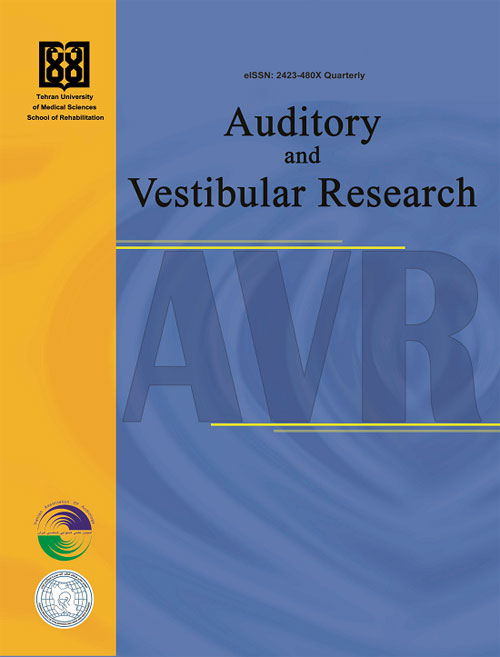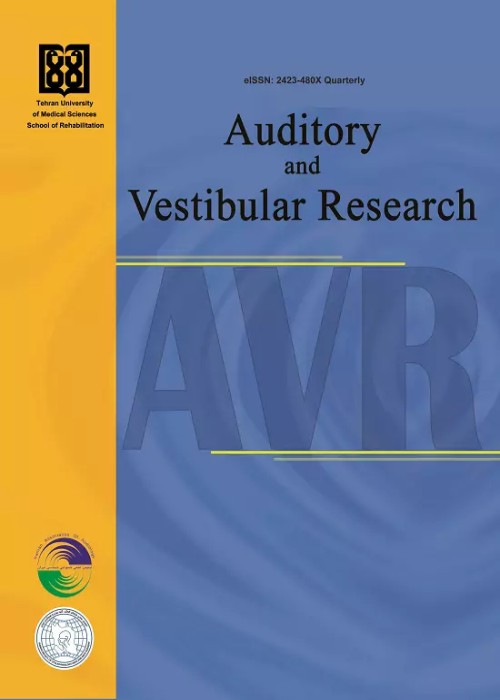فهرست مطالب

Auditory and Vestibular Research
Volume:29 Issue: 1, Winter 2020
- تاریخ انتشار: 1398/10/23
- تعداد عناوین: 8
-
-
Pages 1-9Background and Aim
Since the first report of recording the binaural interaction component (BIC) in 1970, many studies have been conducted on BIC but none of them make its way to clinical application yet. The present paper aims at reviewing the characteristics and potential applications of BIC in audiology.
Recent FindingsBIC may be a potentially sensitive objective tool in identifying subjects with auditory processing disorders and monitoring auditory training effects. It can also help effective electrode insertion in bilateral cochlear implantation. Besides, BIC has shed light on the binaural processing maturation in infants. BIC recoding faces some difficulties as it is sensitive to noise and presentation rate, and has low amplitude, especially in brainstem level. These issues might contribute to its limited clinical applications.
ConclusionAlthough BIC has not been introduced as an objective tool for testing binaural processing, it has the potential to be a reliable test. Furthermore, BIC may be used in situations where no behavioral test can be conducted. Such circumstances are during cochlear implan tation or testing uncooperative pre-school children for auditory processing or the lack of standard behavioral tests for them. Further research on BIC is highly recommended before it can gain any clinical application.
Keywords: Binaural interaction, cochlear implant, spatial processing, auditory processing -
Pages 10-25Background and Aim
As deaf children grow up, they face difficulties that can affect their physical, emotional, motor, and cognitive development. This study reviews the recent studies conducted on motor development of deaf children based on Gallahue's model.
Recent FindingsFew studies have been conducted on deaf children's motor development stages; reflexive, rhythmic, rudimentary, and specialized movement. However, many studies investigated the fundamental movement stage with an emphasis on balance. They mostly reported the deaf children’s delay in developing gait velocity (during walking), postural control, static balance, dynamic balance, spatial-temporal coordination, gross motor skills, fine motor skills, and motor skills learning, compared with their healthy peers.
ConclusionDelay in motor development in deaf children is not necessarily the result of deafness or vestibular problems, but individual, environmental, and exercise factors are also involved. Providing appropriate educational opportunities for these children, training specia lized teachers and parents, and holding training courses for hearing specialists can help promote motor development in these children.
Keywords: Motor development, deaf children, fundamental motor skill, Gallahoe's motor development perspective -
Pages 26-31Background and Aim
Biotinidase deficiency (BTD) is a rare autosomal recessive abnormality of biotin metabolism. If left untreated, it may lead to auditory symptoms. In this study, we examined the possible relationship between BTD and hearing impairment among Iranian children.
MethodsThis descriptive cross-sectional study was performed on 9 children (8 boys, 1 girl) with BTD, who referred to Imam Hossein Hospital in Isfahan City, Iran, in 2018. After collecting their demographic data, including age, gender, weight, height, and history of diseases, we performed routine otolaryngologic and neurologic examination, audiological examinations, including otoscopic, acoustic immittance measurements, and auditory brainstem response (ABR). We recorded cochlear microphonic results in most cases, too.
ResultsThe subjects’ mean ± SD age of BTD diagnosis was 4.33 ± 5.36 months. Of all participants, 11.1% had a positive family history of the disease, and 66.7% of families had the first-degree consanguineous marriage. About 44.5% of participants had a normal hearing; 22.2% had moderate sensorineural hearing loss, and 33.3% showed no response to ABR test. All subjects showed normal acoustic immittance results. However, children with profound hearing loss showed bilateral absence of acoustic reflexes.
ConclusionBTD has a high impact on a child’s hearing system. The high prevalence of hearing loss among BTD patients suggests that parents of BTD children (diagnosed at birth) should pay special attention to auditory screening and follow-up programs, as early diagnosis is important for preventing hearing loss. Also, families with first-degree of consanguineous marriages should consider genetic counseling before having children.
Keywords: Biotinidase deficiency, hearing impairment, children -
Pages 32-38Background and Aim
In unilateral sudden sensorineural hearing loss (SSNHL), the vestibular system may be involved in addition to the auditory system. Several hearing assessments have shown that the disease course and the patient's improvement, at least two step of vestibular assessments can help in better control of the patient's balance function. The aim of this study was to evaluate the results of cervical vestibular evoked myogenic potentials (cVEMP) and video head impulse test (vHIT) used for assessment of saccule and semicircular canals before and after steroid therapy.
MethodsTwenty three patients with SSNHL were evaluated for auditory and vestibular function before and after steroid therapy. The results of cVEMP and vHIT were compared between intact and impaired ears and between pretest/posttest stages before and after treatment.
ResultsFor 26.08% of patients, the cVEMP response was absent in the affected ear, but after treatment it was reported for all patients. There was a significant difference in vestibulo-ocular reflex (VOR) gain for both posterior and anterior semicircular canals of affected ear before and after treatment, but it was not significantly different after treatment as VOR gain increased.
ConclusionDysfunction of nervous and vestibular systems in SSNHL is possible. Steroid therapy can improve the vestibular function and hearing of these patients. Therefore, vestibular evaluation can be used to determine the extent of lesions in SSNHL.
Keywords: Unilateral sudden sensorineural hearing loss, vestibular evoked myogenic potentials, saccule, semicircular canals, video head impulse test -
Pages 39-47Background and Aim
Digits are suitable speech materials for evaluating recognition of speech-in-noise in clients with the wide range of language abilities. Farsi Auditory Recognition of Digit-in-Noise (FARDIN) test has been developed and validated in learning-disabled children showing dichotic listening deficit. This study was conducted for further validation of FARDIN and to survey the effects of noise type on the recognition performance in individuals with sensory-neural hearing impairment.
MethodsPersian monosyllabic digits 1−10 were extracted from the audio file of FARDIN test. Ten lists were compiled using a random order of the triplets. The first five lists were mixed with multi-talker babble noise (MTBN) and the second five lists with speech-spectrum noise (SSN). Signal- to- noise ratio (SNR) varied from +5 to −15 in 5 dB steps. 20 normal hearing and 19 hearing-impaired individuals participated in the current study.
ResultsBoth types of noise could differentiate the hearing loss from normal hearing. Hearing-impaired group showed weaker performance for digit recognition in MTBN and SSN and needed 4−5.6 dB higher SNR (50%), compared to the normal hearing group. MTBN was more challenging for normal hearing than SSN.
ConclusionFarsi Auditory Recognition of Digit-in-Noise is a validated test for estimating SNR (50%) in clients with hearing loss. It seems SSN is more appropriate for using as a background noise for testing the performance of auditory recognition of digit-in-noise.
Keywords: Auditory recognition, hearing loss, speech perception in noise, digit recognition in noise -
Pages 48-53Background and Aim
It is well known that hearing aid fitting is an effective approach to improve the communication ability of hearing-impaired people. In the past, most of the hearing aids were fitted unilaterally rather than bilaterally. Whereas the unilateral hearing aid fitting improves verbal communication partially, it causes late-onset auditory deprivation. The main aim of this study is to investigate the ANL for each ear among the users with unilateral hearing aid experience.
MethodsA total of 23 participants were recruited (14 females, 9 males). The mean age was 74.65 years (ranged from 41 to 83). All subjects had bilateral symmetric sensorineural hearing loss. The most comfortable level (MCL), Background Noise Level (BNL), and acceptable noise level (ANL) were measured for ear with amplification experience and ear without experience.
ResultsMCL, BNL and ANL in the aided ear was 82.22, 73.48 and 8.74 respectively, in addition in the unaided ear the results for MCL, BNL and ANL was 81.78, 72.13 and 9.65 respectively. Comparing the mean values of MCL, BNL and ANL between two ears showed no significant difference.
ConclusionThere was not any difference for BNL and ANL measures.
Keywords: Bilateral hearing loss, acceptable noise level, late onset auditory deprivation, Hearing aid -
Pages 54-59Background and Aim
Balance disorder is a common problem in post stroke patients. Vibration therapy is one of the interventions that is used to treat this impairment in physiotherapy. There are several studies on the effects of more affected foot plantar vibration on balance, however according to the researchers this cerebral lesion causes bilateral side effects in the body. So the aim of this study was to investigate the short-term effects of both feet plantar vibration on the balance of post stroke patients.
MethodsThis pretest-posttest clinical study included 12 post stroke patients (8 male and 4 female, mean age 52.41 ± 9.03 years). The participants received one session of 5-min vibration stimuli (frequency, 100 Hz) to the plantar region on both feet. Mini-Balance Evaluation Systems Test (Mini-BESTest) score and plantar cutaneous sensation by Semmes Weinstein monofilament examination (SWME) were assessed before and immediately after the intervention.
ResultsMini-BESTest mean total score improved significantly (p ≤ 0.001) after both feet vibration and these results were supported by a large effect size (Cohen d = 2.83). Mean number of detected points by SWME decreased after vibration therapy (p = 0.06) but it was not statistically significant.
ConclusionThe findings suggest that local vibration applied directly to the plantar region of both feet in post-stroke patients could be an appropriate physiotherapy intervention to improve their balance.
Keywords: Vibration, balance, stroke -
Pages 60-63Background
Auditory steady-state response (ASSR) is a test for the estimation of auditory thresholds. It is used in infants, children, and adults. This case report presented unusual ASSR results in an elderly person.
The CasePure tone and speech audiometry, tympanometry and acoustic reflexes showed a moderate sensorineural hearing loss in both ears. However, the patient did not respond in the ASSR test to different carrier frequencies with frequency modulations of 40 and 80 Hz.
ConclusionTo date, the results of the different effects of the aging process obtained from ASSR responses have been reported. However, the absence of any response in the ASSR test has never been reported. The patient in this case report may have these results because of a neural deficit.
Keywords: Sensorineural hearing loss, aging, auditory steady-state response


